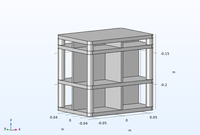HighTech solutions for the ceramic sintering process - Realistic simulation of the sintering process.
sico-solutions has developed a sintering model for ceramics with which all relevant processes such as shrinkage and deformation can be calculated in a practical way. This allows, for example, the shape and stress distribution in a 3D-printed ceramic component to be determined after passing through the sintering process.
All the material parameters required for this can be measured by standard tests. In particular, this new process technology can be used to determine the surface energy, which is difficult to access experimentally.
The calculations with our simulation tools agree very well with the results of real sintering processes.
The performance of our process is demonstrated in the following pictures.
Fig. 1 shows the green body of a typical ceramic kiln furniture. The design of the green body, taking into account sintering shrinkage and deformation, is generally based on empirical values. An evaluation of the quality is only possible after the sintering process. By adjusting the shape of the green body again, an improvement is expected in the subsequent sintering process, The procedure thus generally consists of trial and error tests.
This is where our process technology comes in, which can be used to calculate how the design of a green body must look so that it has the desired shape after the sintering process.
The following picture (Fig. 2) shows the sintered kiln furniture after a suboptimal design of the green compact and control of the sintering process. After the sintering process, the kiln furniture shows significant distortions. Our goal was to reproduce this sintering process with our simulation technology. The result of the simulation calculation compared with the real case shows very nicely the agreement between simulation and reality.
Further, it is shown how the desired quality of the ceramic product can be optimized in such a way that the distortions are minimized and the desired shape is obtained after sintering. The green compact is optimized before sintering. The green compact then exhibits the shape necessary to compensate for shrinkage and deformation during sintering. The result is a ceramic part with the desired shape and minimal stresses.
Have we aroused your interest? We would be happy to show you how you can increase your quality and productivity with our process technology.
HighTech Solutions for the Ceramic Sintering Process - Shape Optimization of Ceramics by Sintering Compensation
The sintering process typically takes place at defined heating times as well as under a suitable atmosphere, which is adapted for the respective ceramic.
It is of particular importance to produce the ceramic pressure parts as stress-free as possible, i.e. that thermal stress formation is minimized or becomes negligible during the sintering process. Since shrinkage of the component occurs, this shrinkage must be taken into account as an allowance in the green compact, for example, when manufacturing 3d printed bodies. In practice, empirical or estimated values are used, the usefulness of which can be measured by the quality of the end product after firing. For this reason, several elaborate tests are often necessary in practice in order to find suitable stock allowances.
This is where our production optimization comes in. Our process technology can predict how a green compact must be printed so that it has the desired shape after the firing process and the associated shrinkage.
Our shape optimization for sintering compensation is based on inverse modeling of the sintering process. Inverse modeling consists of a shape optimization procedure that calculates the required green body in advance.
The practicality of our method is demonstrated using a bar from the experiment to determine the pyroplastic index.
Fig. 3a shows the deformation that the bar undergoes during sintering. After the firing process, the bar exhibits a curved shape. This deformation has to be compensated for in advance of sintering by means of a precalculation so that the bar has as straight a shape as possible after sintering. The aim of the optimization is thus to adapt the geometry of the bar so that it returns to the shape of the original bar after sintering.
The shape of the bar after the sintering process is shown in Fig. 3b. After the firing process, the bar has the required straight shape.
Our mold-opining process has designed the shape of the bar in such a way that the undesired curvature is compensated for by the appropriate design of the green compact. The bending at the ends occurs because the support points were not fixed during the firing process.
Use our high-tech process technology to increase the quality and save time and costs for your ceramic products. We will be happy to work with you to develop a customized process for your applications.
